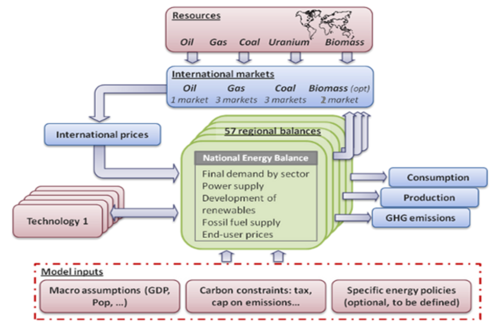Model scope and methods - POLES: Difference between revisions
m (1 revision imported) |
mNo edit summary |
||
| (4 intermediate revisions by the same user not shown) | |||
| Line 3: | Line 3: | ||
|DocumentationCategory=Model scope and methods | |DocumentationCategory=Model scope and methods | ||
}} | }} | ||
POLES ('''Prospective Outlook on Long-term Energy Systems''') is a global recursive dynamic simulation model of the energy system and covers all anthropogenic greenhouse gases emissions. | |||
It allows to simulate a wide range of energy policies, be they on the demand side or on the supply sector. It displays a high regional resolution and sectoral representation, and provide endogenous simulation of all steps of the energy system by vector and sector: final energy demand, transformation (including power generation), trade, primary supply, international and final user prices. | |||
* The model describes full energy balances for multiple countries and regions covering the whole world, and primary supply for a different geographical disaggregation, as well as energy commodities trade and trade routes. | |||
* It operates on a yearly time step and benefits from frequently updated databases, allowing it to capture the most recent developments of energy markets in various countries / regions. | |||
* Additional modules allow covering GHG emissions from industrial sources; agriculture and land-use emissions are derived from linkages with specialized models. | |||
<xr id="fig:POLES_1"/> below gives a schematic view of the POLES model. The red boxes are the main assumptions, calibration and scenario settings; the green box represents the energy balance resolution by country / region and the blue boxes represent the trade and key outputs (demand, supply, emissions). | |||
<figure id="fig:POLES_1"> | |||
[[File:36405496.png|none|500px|thumb|<caption>General scheme of POLES</caption>]] | |||
</figure> | |||
Key input assumptions are population and growth of GDP per capita. The economic activity is then derived by the model at sectoral level, depending on economic growth and energy prices: economic sector value added, passengers and goods mobility, building stocks, etc.. | |||
Other critical assumptions are energy resources by type and localization. | |||
The model has been used in cross-model comparison exercises and it has been tested in the framework of establishing diagnostic indicators to characterize model responses [[CiteRef::kriegler2015di]]. It has been used in several studies looking at transformation pathways of the energy system for the 21st century and the consequences in terms of emissions mitigation policies and technologies mix [[CiteRef::EC 2003]][[CiteRef::EC 2006]][[CiteRef::kitous2010tr]]. More recently, it has been used by the European Commission in its [http://ec.europa.eu/jrc/geco Global Energy and Climate Outlook]. | |||
Latest revision as of 11:53, 3 February 2017
| Corresponding documentation | |
|---|---|
| Previous versions | |
| Model information | |
| Model link | |
| Institution | JRC - Joint Research Centre - European Commission (EC-JRC), Belgium, http://ec.europa.eu/jrc/en/. |
| Solution concept | Partial equilibrium (price elastic demand) |
| Solution method | SimulationRecursive simulation |
| Anticipation | Myopic |
POLES (Prospective Outlook on Long-term Energy Systems) is a global recursive dynamic simulation model of the energy system and covers all anthropogenic greenhouse gases emissions.
It allows to simulate a wide range of energy policies, be they on the demand side or on the supply sector. It displays a high regional resolution and sectoral representation, and provide endogenous simulation of all steps of the energy system by vector and sector: final energy demand, transformation (including power generation), trade, primary supply, international and final user prices.
- The model describes full energy balances for multiple countries and regions covering the whole world, and primary supply for a different geographical disaggregation, as well as energy commodities trade and trade routes.
- It operates on a yearly time step and benefits from frequently updated databases, allowing it to capture the most recent developments of energy markets in various countries / regions.
- Additional modules allow covering GHG emissions from industrial sources; agriculture and land-use emissions are derived from linkages with specialized models.
<xr id="fig:POLES_1"/> below gives a schematic view of the POLES model. The red boxes are the main assumptions, calibration and scenario settings; the green box represents the energy balance resolution by country / region and the blue boxes represent the trade and key outputs (demand, supply, emissions).
<figure id="fig:POLES_1">
</figure>
Key input assumptions are population and growth of GDP per capita. The economic activity is then derived by the model at sectoral level, depending on economic growth and energy prices: economic sector value added, passengers and goods mobility, building stocks, etc..
Other critical assumptions are energy resources by type and localization.
The model has been used in cross-model comparison exercises and it has been tested in the framework of establishing diagnostic indicators to characterize model responses kriegler2015di. It has been used in several studies looking at transformation pathways of the energy system for the 21st century and the consequences in terms of emissions mitigation policies and technologies mix EC 2003EC 2006kitous2010tr. More recently, it has been used by the European Commission in its Global Energy and Climate Outlook.
